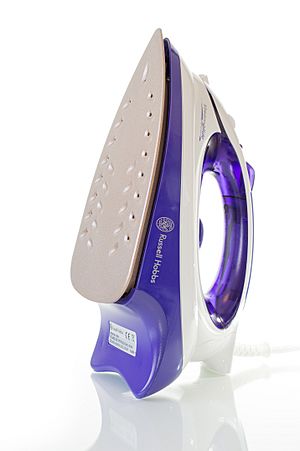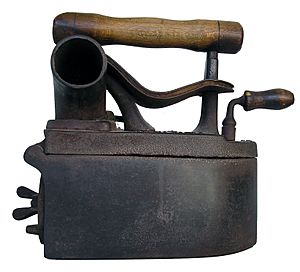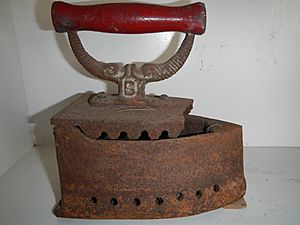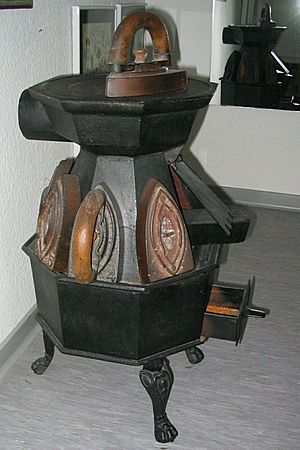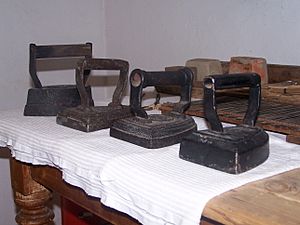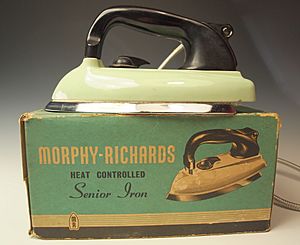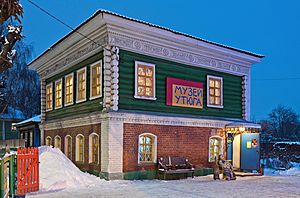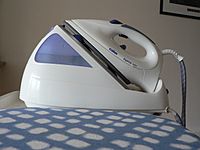Electric iron facts for kids
A clothes iron is a small tool that gets hot and is used to make clothes smooth. It helps remove wrinkles and unwanted folds. Most irons used at home get as hot as 121°C (250°F) to 182°C (360°F). The iron gets its name from the metal it was often made from in the past. Using an iron is called ironing, which is usually the last step when you are doing laundry.
Ironing works by loosening the connections between tiny chains of molecules in fabric fibers. When the iron's heat and weight press down, the fibers stretch out. The fabric then stays smooth once it cools down. Some materials, like cotton, need a little water to help loosen these connections even more.
Contents
History of Irons
For a long time, irons got hot from fire or from something burning inside them. The first "electric flatiron" was invented by an American named Henry W. Seeley. He received a patent for it on June 6, 1882. This early electric iron was very heavy, weighing almost 7 kilograms (15 pounds), and took a long time to heat up.
Some of the oldest irons were metal containers filled with hot coals, or just solid pieces of metal that were heated directly. In China, people used metal pans with hot coals to smooth fabrics as far back as the 1st century BC. Later, some irons were iron boxes that could be filled with hot coals. People sometimes used bellows to blow air into these boxes to keep the coals burning.
In the late 1800s and early 1900s, many irons used fuels like kerosene, ethanol, or even gasoline to get hot. Some homes even had pipes to bring natural gas to irons and lights! Even though these irons could be a fire risk, they were sold in rural areas of the U.S. until World War II. In India, people in Kerala still sometimes use burning coconut shells instead of charcoal for their irons, especially when the power goes out.
From the 1600s, people started using sadirons or flat irons. The word "sad" here means "solid" or "heavy." These were thick, triangular pieces of cast iron with a handle. They were heated in a fire or on a stove. Laundry workers would often have several of these irons. As one iron cooled down, they could quickly swap it for a hot one.
Today, most irons are electric. They use electrical resistance to create heat. The hot bottom plate, called the soleplate, is usually made of smooth aluminium or stainless steel. Sometimes it has a special coating to help it glide easily over clothes. A thermostat inside the iron turns the heat on and off to keep the temperature just right.
The first electric irons didn't have a way to control their temperature. The first electric iron with a thermostat came out in the 1920s. Later, people started using steam to iron clothes. The first electric steam iron that was sold to the public came out in 1926. However, it wasn't very popular. Max Skolnik received a patent for an electric steam iron in 1934. His design became popular in the 1940s and 1950s, leading to the widespread use of steam irons we see today.
Different Types of Irons
Over time, irons have had many different names and designs:
- Flatiron or Smoothing Iron: This is the general name for a simple hand-held iron with a handle and a flat, solid metal base.
- Sad Iron: This means a "solid" or heavy iron. It usually refers to irons with a heavier base than a typical flatiron.
- Box Iron or Charcoal Iron: These irons have a hollow base that could be filled with hot coals or a heated metal block to keep them warm.
- Goose or Tailor's Goose: This is a type of flat iron named for the curved shape of its neck, which looks a bit like a goose. Tailors often used them.
- Goffering Iron: This old type of iron had a metal cylinder on a stand. It was used to iron ruffles and collars, making them stiff and wavy.
Keeping Clothes Clean
Properly ironing clothes can help prevent infections, like those caused by lice. The heat from the iron helps kill tiny pests that might be on clothing.
Modern Iron Features
Today's irons for home use have many helpful features:
- A design that lets you stand the iron on its end so the hot bottom plate doesn't touch anything.
- A thermostat to keep the temperature steady.
- A dial to choose the right temperature for different fabrics like silk, wool, cotton, or linen.
- A strong electrical cord with heat-resistant insulation.
- The ability to inject steam into the fabric while you iron.
- A water tank inside the iron to make steam.
- An indicator to show how much water is left.
- Constant steam: Steam flows out all the time.
- Steam burst: A strong puff of steam comes out when you press a button.
- (Advanced) A dial to control how much steam comes out.
- (Advanced) An anti-drip system to stop water from leaking.
- A special spring where the cord connects to keep it out of your way.
- A cord that can retract (pull back in) for easy storage.
- (Advanced) A non-stick coating on the soleplate to help the iron slide smoothly.
- (Advanced) Anti-burn control: If the iron is left flat for too long, it turns off automatically to prevent burning clothes or causing fires.
- (Advanced) Energy saving control: If the iron is left still for a few minutes, it turns off to save power.
- Cordless irons: These irons sit on a stand to heat up and stay hot for a short time. They are good for small amounts of ironing.
- (Advanced) Self-cleaning features to remove mineral buildup.
- (Advanced) Anti-scale features to prevent limescale from hard water.
- (Advanced) Vertical steam: You can hold the iron upright and steam clothes to remove wrinkles without touching them.
Iron Collections
Did you know there are museums just for irons? One of the biggest collections has 1300 historical irons from Germany and around the world. It's located in Gochsheim Castle in Germany. Many museums that show how people lived in the past also have collections of old irons. For example, in Ukraine, the Radomysl Castle has about 150 different irons on display.
Ironing Centers
An ironing center, also called a steam ironing station, is a special setup. It has a clothes iron and a separate tank that makes steam. Because the tank is separate, it can make a lot more steam than a regular iron. This makes steam ironing faster. However, these systems take longer to heat up and usually cost more.
See also
 In Spanish: Plancha de ropa para niños
In Spanish: Plancha de ropa para niños
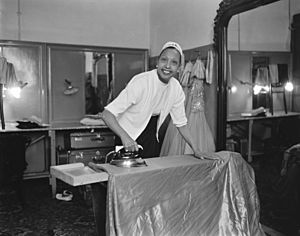
- Hair iron
- Soldering iron
- Mary Florence Potts, who invented a detachable cold wooden handle for irons.


